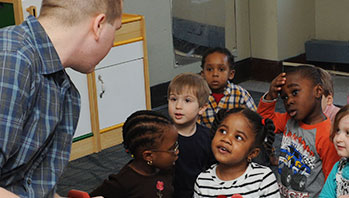- Between the Lions alphabet chart
- alphabet
- curved
- letter
- straight
MA Standards:
Foundational Skills/RF.PK.MA.1: With guidance and support, demonstrate understanding of the organization and basic features of printed and written text: books, words, letters, and the alphabet.
Head Start Outcomes:
Literacy Knowledge/Alphabet Knowledge: Recognizes that the letters of the alphabet are a special category of visual graphics that can be individually named.
Literacy Knowledge/Print Concepts & Conventions: Recognizes print in everyday life, such as numbers, letters, one’s name, words, and familiar logos and signs.
PreK Learning Guidelines:
English Language Arts/Reading and Literature 7: Develop familiarity with the forms of alphabet letters, awareness of print, and letter forms.
Mathematics/Number Sense 1: Listen to and say the names of numbers in meaningful contexts.
Talk Together: What Is the Alphabet?

© Commonwealth of Massachusetts, Department of Early Education and Care (Jennifer Waddell photographer). All rights reserved.
Educator Prep: Print out the Between the Lions alphabet chart or create an alphabet chart on chart paper. Place the chart on display for children to view easily.
Introduce the alphabet to children. Point to the alphabet chart and say,This is the alphabet. It has twenty-six letters in it. Each one of these is a letter. You may want to count the letters with children.
- Have children search for letters around the room. Encourage them to work together with a buddy as they search, for example, Brandon, do you see any letters in the Art Center? Can you show them to Peter? Guide children to recognize letters in books, name cards, signs around the room, etc.
- Once children are finished searching, have them share and point to the different places they found letters in the room.
Now ask children to think of different places they have seen letters. You may need to prompt them to think about the grocery store, street signs, etc. Make a list of responses or have children draw a picture of each place.
- End the discussion by pointing to the alphabet chart again and say, Let’s look closely at all the different letters. Have volunteers talk about what they notice about letters. Point out how some letters have curved lines and some straight lines.
English Language Learners: If children are having trouble understanding what is meant by straight and curved lines, draw examples for them on a sheet of paper. Then guide their fingers as they trace over the lines as you say the words straight and curved. Once they gain understanding, have them trace (or draw) the letters and repeat the words straight and curved on their own.
